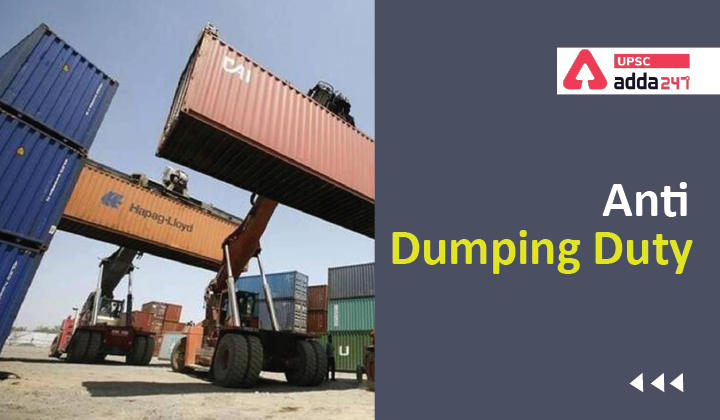Table of Contents
Anti-Dumping Duty: Relevance
- GS 3: Indian Economy and issues relating to planning, mobilization, of resources, growth, development and employment.
Anti-Dumping Duty: Context
- Recently, India has imposed anti-dumping duty on five Chinese products for five years to protect local manufacturers from cheap imports from China.
Anti-Dumping Duty: 5-products
- Flat rolled products of aluminium;
- Sodium hydrosulphite (used in dye industry);
- Silicone sealant (used in manufacturing of solar photovoltaic modules, and thermal power applications);
- Hydrofluorocarbon (HFC) component R-32; and
- Hydrofluorocarbon blends (both have uses in refrigeration industry).
Anti-Dumping Duty: Key points
- These duties were imposed following recommendations of the Directorate General of Trade Remedies (DGTR), investigation arm of Ministry of Commerce and Industries.
- DGTR concluded that these products were exported at a price below normal value in Indian markets, which has resulted in dumping.
- Similarly, CBIC (Central Board of Indirect Taxes and Customs) has also slapped the duty on imports of calcined gypsum powder from Iran, Oman, Saudi Arabia and the United Arab Emirates for five years.
Anti-Dumping Duty: Impacts
- Positive impact: It would help manufacturers garner the market share and hence increase the ease of doing business for these targeted manufacturers.
- Negative impact: It will increase the price of the products and hence the end customer will have to pay the passed-on cost.
What are anti-dumping duties?
- To understand the anti-dumping duties, let us first understand what is dumping.
- Dumping is said to occur when the goods are exported by a country to another country at a price lower than its normal value.
- Dumping is an unfair trade practice which can have a distortive effect on international trade.
- Anti-dumping, therefore, is a measure to rectify the situation arising out of the dumping of goods and its trade distortive effect.
- Thus, the purpose of anti-dumping duty is to rectify the trade distortive effect of dumping and re-establish fair trade.
- Anti-dumping is not synonymous with cheap or low-priced imports. Dumping implies low priced imports only in the relative sense (relative to the normal value), and not in absolute sense.
Anti-Dumping Duty and the WTO
- The WTO Anti-Dumping Agreement allows governments to act against dumping where there is genuine (“material”) injury to the competing domestic industry.
- In order to do that the government has to be able to show that dumping is taking place, calculate the extent of dumping (how much lower the export price is compared to the exporter’s home market price), and show that the dumping is causing injury or threatening to do so.
Anti-Dumping Duty Vs Customs Duty
Though both the taxes are levied and collected by the Customs Authorities, both are completely different.
| Anti-Dumping Duty |
Customs Duty
|
| Linked to fair trade principles. | Means to raise revenue for the overall growth of the nation. |
| These are trade-remedial measures. | They belong to trade and fiscal policies of the Government. |
| These are exporter specific or country specific | These are universal and are applicable to all exports. |
Also Read:





 TSPSC Group 1 Question Paper 2024, Downl...
TSPSC Group 1 Question Paper 2024, Downl...
 TSPSC Group 1 Answer key 2024 Out, Downl...
TSPSC Group 1 Answer key 2024 Out, Downl...
 UPSC Prelims 2024 Question Paper, Downlo...
UPSC Prelims 2024 Question Paper, Downlo...




